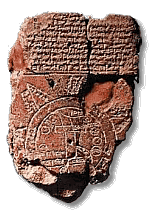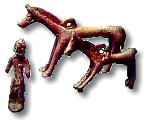 ncestral
Armenians inhabited present day Echmiadzin as early as the 5th millennium
BCE. The surrounding area is called “Armenia’s Cradle of Civilization”
for the numerous mound excavations revealing fortified cities and advanced
cultures going back to the 8th millennium BCE. Among these are
Teghut, MokhraBlur, AdaBlur and Metsamor.
ncestral
Armenians inhabited present day Echmiadzin as early as the 5th millennium
BCE. The surrounding area is called “Armenia’s Cradle of Civilization”
for the numerous mound excavations revealing fortified cities and advanced
cultures going back to the 8th millennium BCE. Among these are
Teghut, MokhraBlur, AdaBlur and Metsamor.
Topography
Echmiadzin lies in Armavir Mars (Armavir Region) and at the Western part of Ararat Valley, once a lake surrounded by volcanoes in the Mesozoic Era (500 million years BC). The volcanoes gave rise to the current mountain ranges rimming the valley (both Mt. Aragats and Mt. Ararat are dormant volcanoes). The receding waters in the Mioceneand Pleistocene Eras ( 10 million -500,000 BC) left behind rich alluvial sediment that nourished large forests and grasslands. The valley remains one of the most fertile in Western Asia.
Echmiadzin also lies in the shadow of Mt. Ararat (the tallest mountain in the world in real measurement from base to summit), which looms over the region like a huge brooding force. The valley has the most fertile soil in Western Asia and its peoples were among the first to cultivate wheat, grapes and apricots. Domesticated wheat has been dated to 12-15,000 years BC, before strains found in Central Anatolia.
The valley was once covered with forests, but mass deforestation begun in the mid Bronze Age turned it into a heavily cultivated land, dependent on irrigation and massive artesian springs.
The springs continue to support the most diverse wildlife population in Europe and Western Asia. More than 2/3rds of Europe's bird species can be spotted in Armavir region during their seasonal migrations, including the endangered Dalmatian Pelican, Greater Flamingo and the Imperial Eagle. Thousands of cranes inhabit the region, building their large nests on the tops of village homes and telephone posts.
Beginnings
As you travel through the valley, you can spot sudden eruptions in the terrain, hills that seem to appear from no where. They do not "fit" the land's contour. These are the remains of the first urban civilization to leave its imprint in Historical Armenia, Armenia's "Cradle of Civilization".
The culture was the earliest known to process bronze and iron, and are believed to be among the first (if not the first) astronomers, mapping the night sky as early as the 3rd millennium BC. Excavations in Armavir include those at Armavir, Yervandashat, Teghut, MokhraBlur, AdaBlur and the largest, Metsamor, a working excavation. These date back 7-9,000 years.
Echmiadzin was itself the site of Bronze Age settlements, with some thought (however controversial) that as a center for early metallurgy, the ciy may have developed into a religious center based on fire and sun worhsip. The pictograms discovered on rock sides in the area are filled with fire, sun and star imagery.
History 1

